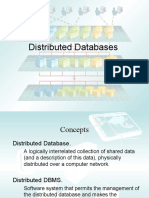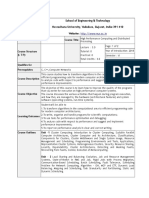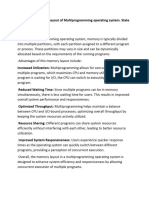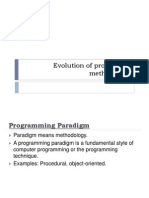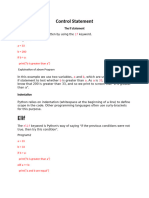0 ratings0% found this document useful (0 votes)
325 viewsDate's Twelve Rules For Distributed Database Systems
Here are the steps to find the names and salaries of employees who are assigned to projects for over 12 weeks in MySQL/SQL:
1. Join the EMP, ASG, and PAY tables on employee number (eno) and title.
2. Filter the results where the assignment duration (dur) is greater than or equal to 12.
3. Select the employee name (ename) and salary (sal) from the joined tables.
So the SQL query would be:
SELECT a.ename, c.sal
FROM EMP a
JOIN ASG b ON a.eno = b.eno
JOIN PAY c ON a.title = c.title
WHERE b.dur >= 12;
Uploaded by
ozila jazzCopyright
© © All Rights Reserved
Available Formats
Download as PDF, TXT or read online on Scribd
0 ratings0% found this document useful (0 votes)
325 viewsDate's Twelve Rules For Distributed Database Systems
Here are the steps to find the names and salaries of employees who are assigned to projects for over 12 weeks in MySQL/SQL:
1. Join the EMP, ASG, and PAY tables on employee number (eno) and title.
2. Filter the results where the assignment duration (dur) is greater than or equal to 12.
3. Select the employee name (ename) and salary (sal) from the joined tables.
So the SQL query would be:
SELECT a.ename, c.sal
FROM EMP a
JOIN ASG b ON a.eno = b.eno
JOIN PAY c ON a.title = c.title
WHERE b.dur >= 12;
Uploaded by
ozila jazzCopyright
© © All Rights Reserved
Available Formats
Download as PDF, TXT or read online on Scribd
You are on page 1/ 3
The University of Faisalabad
Submitted by:
Daud Khalid (Bscs-fa18-015)
BSCS-6th
Subject:
Distributed Database Management System
Submitted to:
Miss Anum Nawaz
Assignment # 1
Department of Computational Science
Amin campus
Question # 1:
Date's Twelve Rules for Distributed Database Systems:
1) Local Autonomy: he sites in a distributed system should be
autonomous. In this context, autonomy means that:
i. Local data is locally owned and managed.
ii. Local operations remain purely local.
iii. All operations at a given site are controlled by that site.
2) No reliance on a central site: There should be no one site without
which the system cannot operate. This implies that there should be no
central servers for services such as transaction management, deadlock
detection, query optimization, and management of the global system
catalog.
3) Continuous Operation: Ideally, there should never be a need for a
planned system shutdown, for operations such as: n adding or
removing a site from the system; n the dynamic creation and deletion
of fragments at one or more sites.
4) Location Independence: Location independence is equivalent to
location transparency. The user should be able to access the database
from any site. Furthermore, the user should be able to access all data
as if it were stored at the user’s site, no matter where it is physically
stored.
5) Fragmentation Independence: The user should be able to access the
data, no matter how it is fragmented.
6) Replication Independence: The user should be unaware that data
has been replicated. Thus, the user should not be able to access a
particular copy of a data item directly, nor should the user have to
specifically update all copies of a data item.
7) Distributed query processing: The system should be capable of
processing queries that reference data at more than one site.
8) Distributed transaction processing: The system should support the
transaction as the unit of recovery. The system should ensure that
both global and local transactions conform to the ACID rules for
transactions, namely: atomicity, consistency, isolation, and durability.
9) Hardware independence: It should be possible to run the DDBMS
on a variety of hardware platforms.
10) Operating system independence: As a corollary to the previous
rule, it should be possible to run the DDBMS on a variety of
operating systems.
11) Network independence: Again, it should be possible to run the
DDBMS on a variety of disparate communication networks.
12) Database independence: It should be possible to have a DDBMS
made up of different local DBMSs, perhaps supporting different
underlying data models. In other words, the system should support
heterogeneity. The last four rules are ideals. As the rules are so
general, and as there is a lack of standards in computer and network
architectures, we can expect only partial compliance from vendors in
the foreseeable future.
Question # 2:
Find the names and salaries of employees who are assigned to projects for over
12 weeks.
Practical in MySQL/SQL?
Query:
SELECT a.ename, c.sal
FROM EMP a, ASG b, PAY c
WHERE a.eno = b.eno
AND a.title = c.title
AND b.dur >= 12;
You might also like
- Lecture 4: Unix Security Basics: Asoc. Prof. Guntis Barzdins Asist. Girts FolkmanisNo ratings yetLecture 4: Unix Security Basics: Asoc. Prof. Guntis Barzdins Asist. Girts Folkmanis67 pages
- VIP300 Protection Application Guide 2004 ENG PDF100% (1)VIP300 Protection Application Guide 2004 ENG PDF24 pages
- Unit-Iii Distributed Objects and Remote InvocationNo ratings yetUnit-Iii Distributed Objects and Remote Invocation12 pages
- Chapter 1 - Introduction To Computer NetworkNo ratings yetChapter 1 - Introduction To Computer Network54 pages
- Darshan Institute of Engineering & TechnologyNo ratings yetDarshan Institute of Engineering & Technology49 pages
- Operating System: Operating Systems: Internals and Design PrinciplesNo ratings yetOperating System: Operating Systems: Internals and Design Principles81 pages
- Access Control Models and Methods - Types of Access ControlNo ratings yetAccess Control Models and Methods - Types of Access Control12 pages
- CCS335-Cloud-Computing-QB - Unit 3, 4 & 5No ratings yetCCS335-Cloud-Computing-QB - Unit 3, 4 & 557 pages
- Unit Iii Virtualization Infrastructure and Docker Desktop VirtualizationNo ratings yetUnit Iii Virtualization Infrastructure and Docker Desktop Virtualization20 pages
- UNIT-1 Introduction To Scripting Languages: 1.1 Scripts and Programs100% (2)UNIT-1 Introduction To Scripting Languages: 1.1 Scripts and Programs34 pages
- Chapter 4 Physical and Logical SecurityNo ratings yetChapter 4 Physical and Logical Security22 pages
- Confidentiality, Integrity, and Availability in Network Systems: A Review of Related LiteratureNo ratings yetConfidentiality, Integrity, and Availability in Network Systems: A Review of Related Literature10 pages
- Virtualization & Software Defined NetworkingNo ratings yetVirtualization & Software Defined Networking58 pages
- Fragmentation: Univ.-Prof. Dr. Peter Brezany Institut Für Scientific Computing Universität WienNo ratings yetFragmentation: Univ.-Prof. Dr. Peter Brezany Institut Für Scientific Computing Universität Wien17 pages
- Q. Describe Memory Layout of Multiprogramming Operating System. State It's AdvantageNo ratings yetQ. Describe Memory Layout of Multiprogramming Operating System. State It's Advantage9 pages
- Evolution of Programming Methodologies and Consepts of Oop100% (1)Evolution of Programming Methodologies and Consepts of Oop48 pages
- Equity of Cybersecurity in the Education System: High Schools, Undergraduate, Graduate and Post-Graduate Studies.From EverandEquity of Cybersecurity in the Education System: High Schools, Undergraduate, Graduate and Post-Graduate Studies.No ratings yet
- Applications of Newton Raphson Method in Computational Sciences100% (1)Applications of Newton Raphson Method in Computational Sciences3 pages
- Artificial Inteligence (A Smart Mobile Robot To Detect Abnormalities in Hazardous Zones)No ratings yetArtificial Inteligence (A Smart Mobile Robot To Detect Abnormalities in Hazardous Zones)5 pages
- Good Design and Bad Design (Software Engeneering)No ratings yetGood Design and Bad Design (Software Engeneering)5 pages
- The University of Faisalabad: Submitted byNo ratings yetThe University of Faisalabad: Submitted by3 pages
- Topic2 - Influence Lines For Statically Indeterminate BeamsNo ratings yetTopic2 - Influence Lines For Statically Indeterminate Beams21 pages
- Crate Conditioning of Bongo (Tragelaphus Eurycerus) For Veterinary and Husbandry Procedures at The Denver Zoological GardensNo ratings yetCrate Conditioning of Bongo (Tragelaphus Eurycerus) For Veterinary and Husbandry Procedures at The Denver Zoological Gardens8 pages
- Archer Avenue St. Patrick's Day Parade 2024No ratings yetArcher Avenue St. Patrick's Day Parade 20242 pages
- Manual de Utilizare Masina de Spalat IndesitNo ratings yetManual de Utilizare Masina de Spalat Indesit84 pages
- Why Do Local Governments Return Money To The Treasury?No ratings yetWhy Do Local Governments Return Money To The Treasury?1 page
- KAS - 2020 Prelims - Gs - 1 (Foresightkas)No ratings yetKAS - 2020 Prelims - Gs - 1 (Foresightkas)20 pages
- The Narcotic Drugs and Psychotropic Substances NDPS Act, 1985No ratings yetThe Narcotic Drugs and Psychotropic Substances NDPS Act, 198557 pages
- ELYM 115 2nd Opp Examination MC-2022-09-21 TTNo ratings yetELYM 115 2nd Opp Examination MC-2022-09-21 TT3 pages
- Beneheart R12: Peripherals and CommunicationsNo ratings yetBeneheart R12: Peripherals and Communications4 pages
- Ergonomics Intervention Program To Train Water Measurers (Al-Kayyals) For Work at Foggara Irrigation System in AlgeriaNo ratings yetErgonomics Intervention Program To Train Water Measurers (Al-Kayyals) For Work at Foggara Irrigation System in Algeria8 pages
- Cadbury Presentation - Group 3 - Consumer Behavior0% (1)Cadbury Presentation - Group 3 - Consumer Behavior28 pages
- Department of Education: Republic of The PhilippinesNo ratings yetDepartment of Education: Republic of The Philippines7 pages
